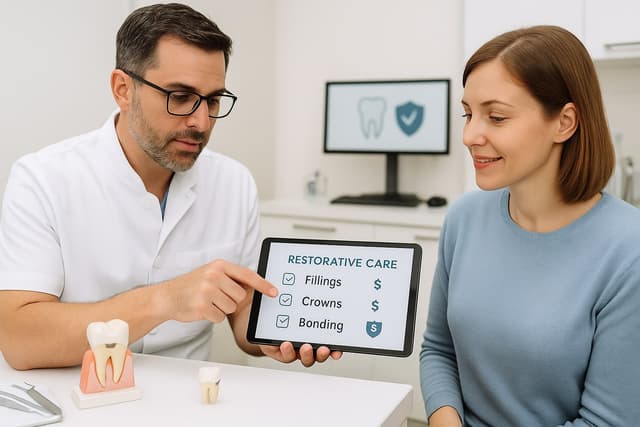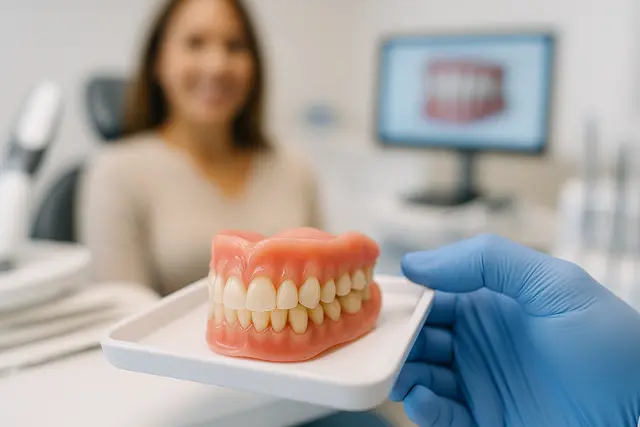Prosthodontics
Severe Tooth Decay Before and After: Treatments That Make a Difference
Tooth decay isn’t just a childhood problem, it’s a progressive condition that can affect anyone, often without warning. What starts as minor discomfort can quickly turn into serious dental damage if left unchecked. The good news? Modern dentistry offers powerful solutions that can reverse the damage and restore your smile.
6 min read
Jul 20, 2025

Tooth decay has a sneaky way of starting small and then snowballing into a full-blown dental disaster. One day it’s a little sensitivity to ice cream, the next you’re wincing with every sip of coffee and staring at dental photos online, wondering how your smile took such a turn. But here’s the good news, there are treatment options that can completely turn things around. And yes, the before and after of severe tooth decay can be pretty dramatic.
Let’s walk through what happens, how decay progresses, and the real-life treatments that save smiles every single day.
Understanding Decay and Why It Happens
Decay doesn’t happen overnight. It’s a process, one that begins when bacteria in your mouth feed on sugars and starches, producing acids that wear down your tooth enamel. This is the earliest stage, often invisible to the naked eye but still quietly attacking the outermost layer of your teeth.
If not stopped, this tooth decay progresses through the enamel and into the dentin, the softer tissue underneath. Once decay reaches the inner portion of your tooth, where the nerves and blood vessels live (also known as the pulp, the innermost layer of your tooth), it can cause pain, infection, and even tooth loss.
Cavities develop as small holes in the enamel. Left untreated, they become deeper, affecting your tooth tissue, causing tooth abscesses, and possibly leading to swollen lymph nodes in your neck. That’s when things get serious.
Tooth Decay Can Affect People of All Ages
Tooth decay doesn’t discriminate. It affects your teeth whether you’re 8 or 80. Kids might get cavities from skipping brushing, but adults face different risks, like receding gums, exposed root surfaces, or even an old filling that’s started to leak. And when decay sets in near the gum line or on the back teeth where it's harder to reach, it’s easy for the problem to go unnoticed until it starts to really cause pain.
Tooth Decay Before and After Treatment
In the early stages of tooth decay, a simple fluoride treatment might be enough. Fluoride helps remineralize the enamel and prevent tooth decay from progressing. If caught early enough, you can avoid fillings entirely. That’s the dream, right?
But when the decay reaches the dentin or even deeper, more serious dental work is needed. This might include:
A filling made from resin or dental amalgam to restore the shape and function of the tooth
A root canal treatment if the pulp is infected
A dental implant to replace a decayed tooth that couldn’t be saved
The before picture? A decayed tooth that’s dark, painful, and may even have a visible hole in the tooth. The after? A natural-looking restoration that blends with your smile. Our smile gallery says it all, those transformations are real and achievable.
Tooth Decay and Cavity Fixes You Can Count On
Let’s talk cavity care. Once decay has created a tooth cavity, your dentist will need to clean out the damaged portion of your tooth and place a filling. There are different types of cavities and matching filling materials: resin for natural appearance, amalgam for durability, and sometimes even gold or porcelain, depending on where the cavity is and your personal preference.
If decay reaches the inner pulp, you’ll likely need a root canal treatment to remove the infection and save the tooth. Don’t panic, modern root canals are far less intimidating than they sound. Most patients compare the experience to getting a regular filling.
The Dentist Is Your Smile’s Best Friend
Nobody loves sitting in the chair with their mouth open while a masked human pokes around with sharp tools. But regular dental visits are one of the best ways to prevent tooth decay and spot trouble before it becomes serious.
If you’re noticing signs like tooth sensitivity, dark spots, or persistent tooth pain, it’s time to see a dentist. Catching issues early makes everything easier (and cheaper).
Stages of Tooth Decay and What They Mean for You
The stages of tooth decay follow a pretty predictable pattern:
Earliest stage: Enamel starts to weaken from acid attack. You might not notice anything.
Early stages: A white spot may appear where minerals are lost.
Tooth cavity forms: This is when an actual hole in a tooth appears.
Dentin decay begins: The decay reaches the dentin, causing more sensitivity.
Decay reaches the inner pulp: At this point, the pulp is infected.
Tooth abscess: A pocket of pus forms, causing swelling, severe pain, and possibly swollen lymph nodes.
Tooth may need extraction: If too much of the tooth is gone, your only option may be to replace the missing tooth with an implant.
Each step feels worse than the last, but the good news is that treatment may be possible at every stage. The earlier, the better.
When Decay Affects the Front or Lower Teeth
Tooth decay doesn’t just attack the back teeth where brushing your teeth is more of a chore. Front teeth are just as vulnerable, especially if you have exposed root surfaces or gaps where food and plaque like to settle. Lower teeth, often forgotten during quick brushing, can also suffer.
A decayed tooth in a visible area may affect your confidence, your speech, even your social life. That’s why cosmetic and restorative dentistry work hand in hand, to bring back not just function, but your natural teeth’s appearance too.
Missing Teeth and Dental Implants
Sometimes decay wins. Maybe a tooth can’t be saved, or maybe you already lost one years ago and never replaced it. Missing teeth don’t just affect your bite, they can shift your smile, change your speech, and even make eating tougher.
That’s where implants shine. A dental implant to replace a decayed or missing tooth looks and functions just like the real thing. It’s anchored into your jaw and topped with a crown that matches your other teeth. It’s like getting your smile back with bonus strength. Learn more about how to care for dental implants after placement to keep them lasting for years.
Can You Prevent Tooth Decay? Absolutely.
Want to keep your teeth from tooth decay and avoid another appointment with your dentist? Stick to strong oral hygiene habits. That means brushing your teeth twice a day, flossing daily, and using fluoride toothpaste or a fluoride rinse.
For kids or cavity-prone adults, a sealant applied to the chewing surfaces of molars can help stop decay before it starts. And don’t underestimate the power of regular dental cleanings, they remove dental plaque and help your dentist catch early signs of decay.
When to See a Dentist and What to Expect
You don’t have to wait until your tooth feels like it's going to explode. Tooth sensitivity, a weird taste, an old filling that doesn’t feel right, or pain when chewing, those are all red flags. And if you’ve got receding gums or a history of dental caries, your dentist will want to keep a closer eye.
Treatment options may range from a quick filling to full restorative care. Your dentist will walk you through what’s needed and why. Whether it’s an amalgam or resin filling, a root canal, or an implant, the goal is always the same: saving your tooth and restoring your smile.
Read Next
Related Posts

Prosthodontics
Crown vs Filling Chipped Tooth: A Dentist’s Guide to Quick Repair
Chipping a tooth can turn an ordinary day into a stressful one fast. Whether it happened mid-bite or during a fall, figuring out how to fix it can feel overwhelming. Should you get a filling, or is a crown the better option? Knowing the difference can save your tooth and your sanity.
6 min read
Jul 20, 2025

Prosthodontics
Dental Basic Restorative Services: Cost Coverage and Care Tips
Tooth troubles can strike when you least expect them, whether it’s a sudden crack or a sneaky cavity. Fortunately, restorative dental care offers solutions that not only repair the damage but also restore the health, function, and confidence in your smile.
5 min read
Jul 20, 2025

Prosthodontics
High End Natural Looking Dentures: A Premium Smile Solution
When it comes to replacing missing teeth, no one wants a smile that screams “dentures.” Fortunately, modern dentistry offers high-end solutions that look incredibly real and feel surprisingly natural. Forget everything you thought you knew about fake-looking teeth, today’s dentures are all about confidence, comfort, and custom design.
6 min read
Jul 20, 2025
Don’t have time to research every dentist around you?
See why 30k+ patients trusted us